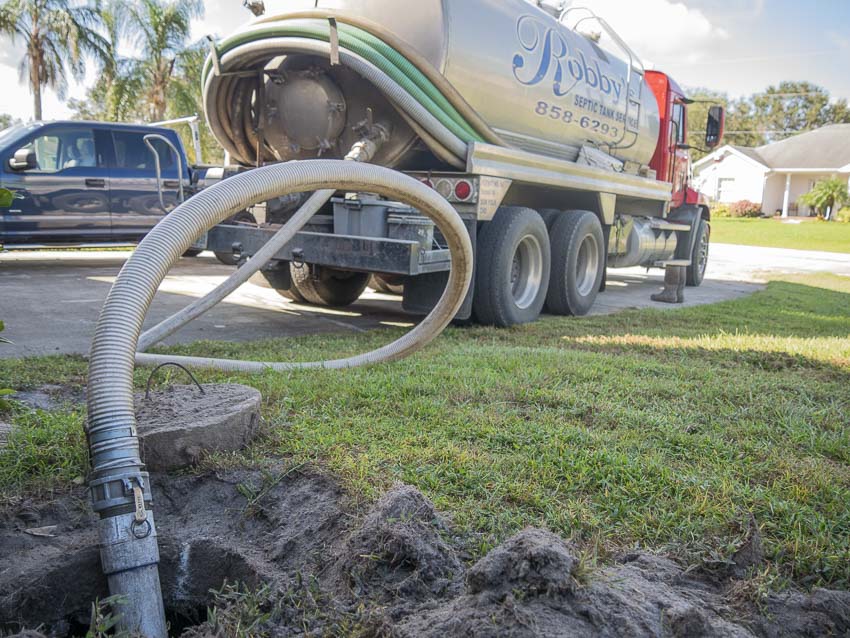Septic system installation costs are usually between $2,000 and $15,000, with the average system costing about $7,000. Septic waste is one of those things that most people don’t like to think about much. If you live in a rural area and aren’t connected to a municipal sewer system, it’s a fact of life that you’ll have to face. This guide covers everything you need to know about septic tank costs, including how a septic system works, the installation costs, and how to tell when your septic tank needs to be pumped.
How a Septic System Works
When you’re the proud owner of a septic tank and drain field, it’s helpful to have a basic understanding of septic systems. Knowing about septic systems helps you understand the costs, the type of maintenance required, and how to tell when something goes wrong.
The Basics of Septic Tank Design and Function
A septic tank, which is either cylindrical or rectangular, utilizes chambers to promote sedimentation of septic waste. The design of a septic tank separates waste into three basic layers, including solids, scum, and effluent. You want the solids to float to the bottom and form sludge. Oils and grease should float to the top while clear effluent flows out to the drain field.
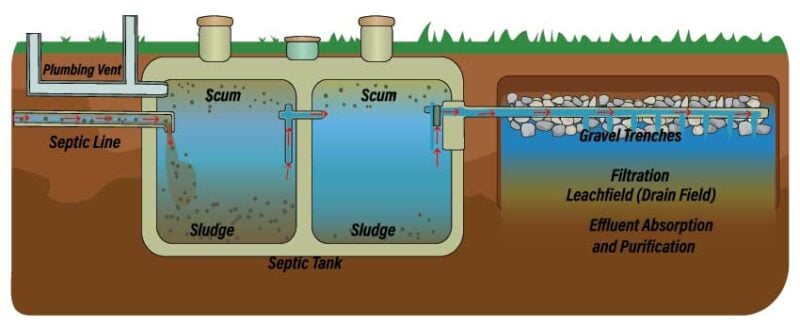
As waste enters the septic tank from the house, it enters the first chamber. This slows the water so that large solids float to the bottom of the tank. Smaller solids, soap scum, and grease float to the top. Anaerobic bacteria in the septic tank naturally help dissolve the solids. This emits gases like methane, carbon dioxide, and hydrogen sulfide in the process. This gives you that “classic” septic tank odor…
Sludge accumulates at the bottom of the septic tank, and a thick layer of floating scum rests on the surface. The bacteria must have enough space between the two layers to do their job. Otherwise, sludge and scum will be forced into the drain field, causing it to clog.
The Role of Drainfields and Soil Absorption
The septic tank is designed so that only clear fluids leave the septic tank and enter the drain field. Septic fields are usually made of perforated drain pipes laid in porous gravel. As effluent pours into the drain field, it leaves the pipe, travels through the gravel, and enters the subsoil, where it percolates into the ground and is purified before reaching groundwater level.
Drainfields are affected by soil type and groundwater levels. Different soil types are more porous, with heavily compacted clay soils being the least permeable. To ensure the proper functioning of a drain field, professionals test the soil prior to installation. This helps determine its suitability as a drainage medium.
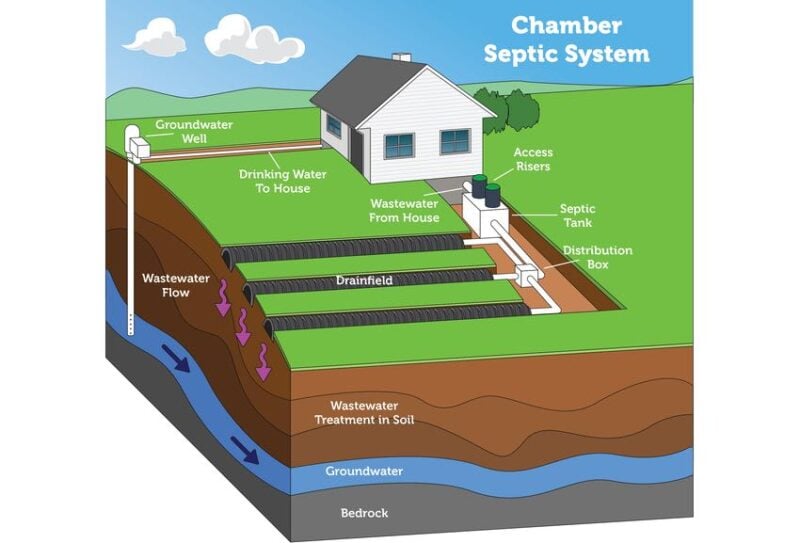
Conventional septic systems aren’t suitable in areas with high water tables. Around the globe, groundwater levels vary from just below the surface to as deep as 30,000 feet. Most groundwater occurs between 50 and 300 feet below ground level.
Septic System Installation Costs: What to Expect
Septic system installation costs are usually between $2,000 and $15,000, with the average system costing about $7,000. The cost of a septic system for your home depends on several factors. This includes permit costs, the tank material, and the size of your household. The latter determines the required tank size.
Site Assessment and Preparation
Before you can install a subsurface septic system on your property, you need a permit from your local health district. This also requires a soil assessment. The health district usually conducts soil percolation tests. It may involve digging a few holes and testing the soil to determine how fast water travels through it.
Percolation tests cost between $250 and $1,800, with the average test costing $1,350. Permits are a separate but related cost, with the average cost of a permit running between $200 and $2,000. You may also need a land survey before installing a septic system, which averages about $2,000 to $2,500.
Septic Tank Materials and Equipment Cost
The cost of a septic tank varies according to the size of the tank and the type of materials. Septic tanks are made of various materials, including concrete, plastic, and fiberglass.
- Concrete septic tanks cost $2,350 to $6,750
- Plastic or poly tanks cost $830 to $2,500
- Fiberglass tanks cost $1,450 to $2,000
Septic systems are made up of several other components. While the tank and drain field represents the largest portion of the costs of a septic system, you may also need other components. These include access risers and tank pumps, depending on the complexity of your system.
Septic Tank Labor Costs and Timeframe
Since most people can’t install a septic system themselves, labor costs are usually one of the most significant expenses. The average labor costs associated with septic system installations are between $1,400 and $4,100.
Timeframes for installing septic systems vary greatly depending on the project’s complexity. Simple installations can take as little as a day. More complicated systems can take up to a week or more to install. Additionally, regulations and inspections can add several weeks to the installation process.
Additional Costs and Considerations
You need heavy equipment to install a septic system. This makes excavation a significant expense when installing a septic tank and drain field. The average cost of excavation for a septic tank is about $3,000. If you have to remove an existing tank before installing a new one, expect to pay more.
Site preparation, which could include things like tree removal costs, averages about $1,200 to $4,500. Installers typically build these expenses into the overall cost of the septic system unless your drain field requires a lot of extra work to clear the area.
You may also need to replace or redesign some landscaping after installing a septic system. Factored this into your costs if your system requires leveling the ground and planting new grass for your lawn.
Septic Tank Maintenance Costs: Keeping Your Septic Tank in Good Condition
Septic systems require regular maintenance. You want to learn more about how often you should expect to have your septic tank pumped. You also want to know how to identify problems with your septic system.
Regular Maintenance Tasks and Frequency
Septic systems are actually simple systems, and maintenance isn’t complicated. Here are the most important things to know about septic system maintenance:
Inspect and pump every three to five years
Regular pumping of septic tanks keeps the entire system working properly. You should pump your tank every three to five years, depending on the size of your household. This also depends upon how much wastewater you generate in relation to the size of your septic tank.
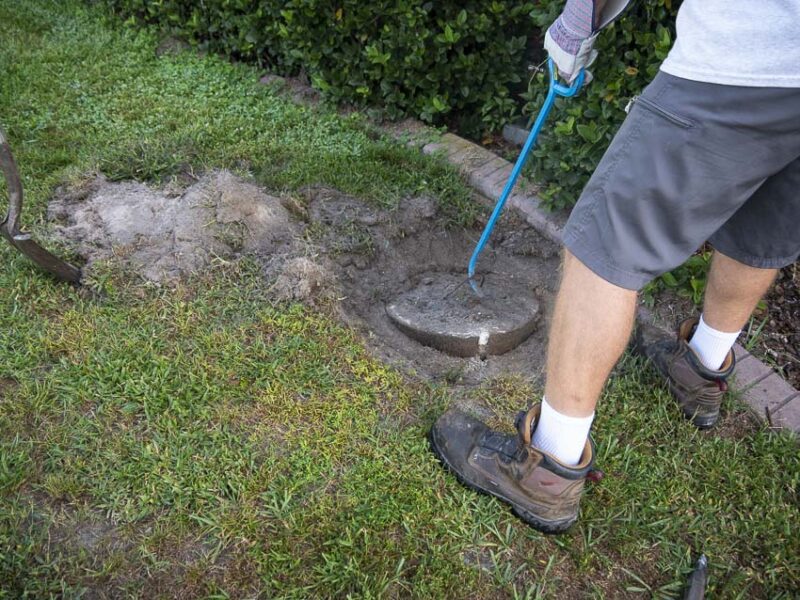
Ensure efficient water usage
Septic systems typically accommodate individual water usage of about 70 gallons per day. A leaky faucet or toilet can waste several hundred gallons of water daily, which strains your septic system. Find ways to conserve indoor water use to avoid overloading your septic system.
Proper waste disposal
When you flush anything down the toilet, it only has one place to go. Septic systems aren’t designed to handle trash. In fact, your system isn’t built to accept anything other than human waste and toilet paper. You should also avoid disposing of toxic chemicals in the septic system because they can destroy the bacteria in your tank.
If you use a drain field filter, clean that at least once per quarter to keep the effluent layer flowing through to the drain field.
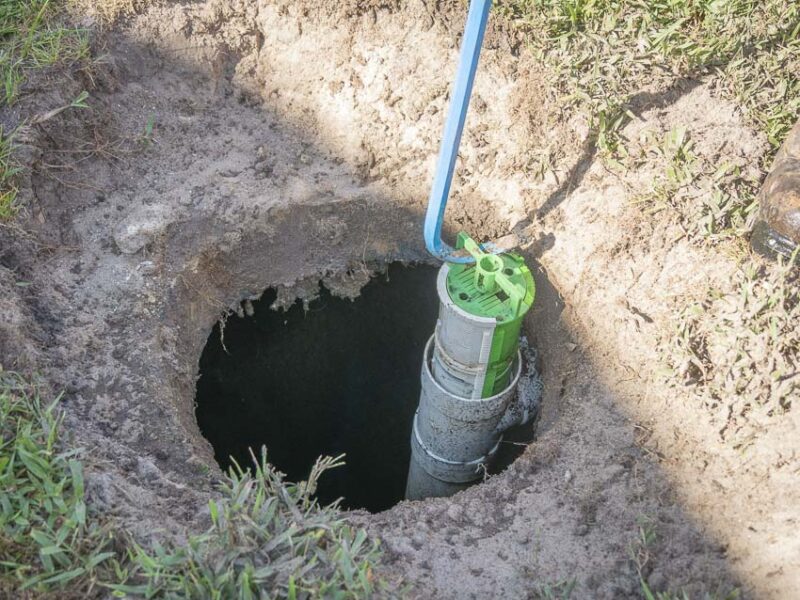
Take care of your drain field
It’s important to protect your drain field. Tree roots can destroy your leach field by growing into the pipes and clogging them, and driving or parking on your drain field can damage it. Also, keep other types of wastewater away by diverting sump pumps and rainwater drainages from the drain field area.
If you have a riser to provide easier access to the septic tank, ensure you use a string trimmer to keep it exposed and easy to access.
Costs of Pumping and Cleaning a Septic Tank
On average, septic tank pumping costs $400, usually between $250 and $600, depending on where you live.
Pumping your tank keeps the system clean and helps you avoid system failures. If you don’t clean it regularly, the sediment layers of sludge at the bottom and scum at the top can overwhelm your system and cause wastewater to back up into the house.
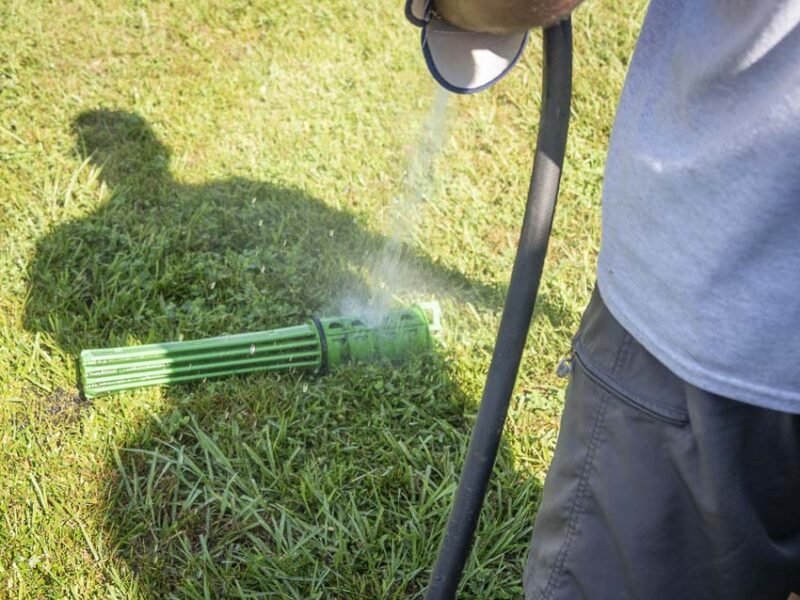
Signs of Septic Tank Problems and Repair Costs
If you notice any of the following signs, you should have your septic tank inspected or pumped immediately.
- Standing water on your drain field
- Strange smells
- Slow drainage
- Patches of grass that are greener
The cost of septic tank repairs varies depending on the actual problems, but on average, you can expect to pay about $1,775, with costs ranging between $650 and $3,000.
Septic System Replacement Costs
The life expectancy of most septic systems is between 25 and 40 years, and you may need to have your system inspected for replacement if the size of your household increases significantly or if your system is older than that.
Signs that Your Septic Tank Needs Replacing
To determine if you need to replace your septic tank, you must rely on a professional inspection. An inspection, which costs about $100 to $200, will cover the tank, field, and the pipes leading from the tank to your house and the drain field. If you also need to pump it out, that costs extra—usually between $250 and $600, depending on the tank size. However, they should charge you for one service or the other, not both.
You should have your tank inspected if you notice it draining slower, gurgling, or backing up into the house. Standing water on your drain field, foul odors, and green patches on your lawn can also indicate septic tank failure. It may require replacement.
Cost Comparison: Septic Tank Repair vs. Replacement
Septic tank replacement costs average between $3,000 to $9,500. This includes the cost of a new tank, removal of the old one, new lines, and excavation. Replacement is much more expensive than septic tank repairs, which cost about $650 on average.
Choosing a New Septic System: Factors to Consider
When installing a new septic tank system, you should consider factors like the size of your household, the size of the tank, the location of the tank and drain field, and accessibility. Because you should pump out your tank every three to five years, you need to take ease of access into account.
Septic Tank Service Costs
Septic service companies provide various services, from installations and inspections to pumping and repairs.
Inspection and Assessment Services
Schedule professional septic system inspections every two to five years or when you notice problems with your septic system. It’s also a good idea to have an objective assessment done when you put your house on the real estate market so prospective buyers can rest assured that the system is in proper working order.
Septic service companies offer inspections, but a public health authority should do the initial permitting inspection. After you install a septic system, a septic service company can provide regular evaluations.
Pumping and Cleaning Services
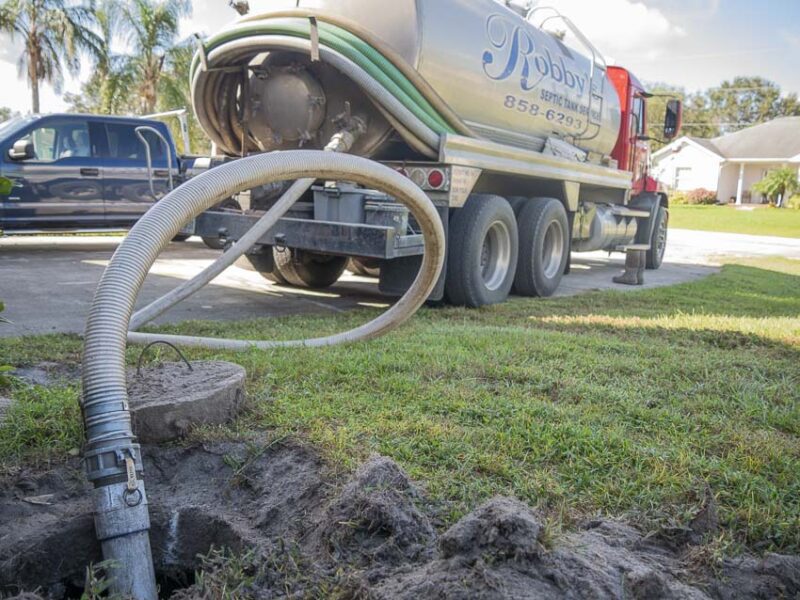
Schedule septic tank pumping and cleaning every three to five years. If you call your septic service company out for pumping services, they should also inspect your system and give you important information about the health of your system.
When pumping your tank, the septic company will run a hose from your tank to their pumper truck. They should be able to remove all the liquids and solids from your tank and transfer them to a sewage treatment plant.
Repair and Replacement Services
The septic service company may recommend repairs or replacements of your tank or drain field after pumping or inspecting your system. They may also point out repairs that you need to make to service lines, lids, or pumps. Have them provide you with a quote to fix the components. Always ask for a written quote from the company before authorizing any work.
Costs of Professional vs. DIY Services
You can save yourself some money by DIYing some of the work to install a septic system, such as preparing the site, digging the trench, or coordinating the permit process. If you have some plumbing skills, you could also make repairs to your service lines or clean out blockages, but drain fields and tank installations and repairs usually require service from skilled professionals. If your system is under warranty, contact the installer before attempting any DIY repairs.
Frequently Asked Questions (FAQs) About Septic System Costs
How often should I have my septic tank pumped?
Most septic tanks need to be pumped every three to five years, but your system should be inspected more often than that. After inspecting your tank, a septic service professional will be able to tell you if it needs to be pumped. Inspections cost between $100 and $200, and pumping costs $250 to $600.
What factors affect the cost of installing a septic system?
Many factors influence the cost of installing a septic tank, including the type of soil, the cost of permits and perc tests, and the size of the system. Larger households require bigger tanks, which cost more to purchase and install.
How long does a septic tank last?
Septic tanks typically last about 30 years, but it depends on the type of tank and the soil conditions. Septic tanks that are built out of high-quality concrete can last 40 to 100 years.
Can I maintain my septic tank myself, or do I need professional help?
A homeowner can do some maintenance tasks to care for a septic system, such as inspecting, cleaning lines, and repairing broken pipes. However, most of the maintenance required to take care of septic tank systems, such as pumping, transporting, and disposing of sewage, requires special equipment and a permit.
How can I tell if my septic tank needs repairing or replacing?
Several signs indicate that your septic tank needs to be repaired or replaced, including slow drains, foul odors, and standing water on drain fields. A professional should inspect your system every two to five years by a professional, but it’s important to keep an eye on it between inspections.

